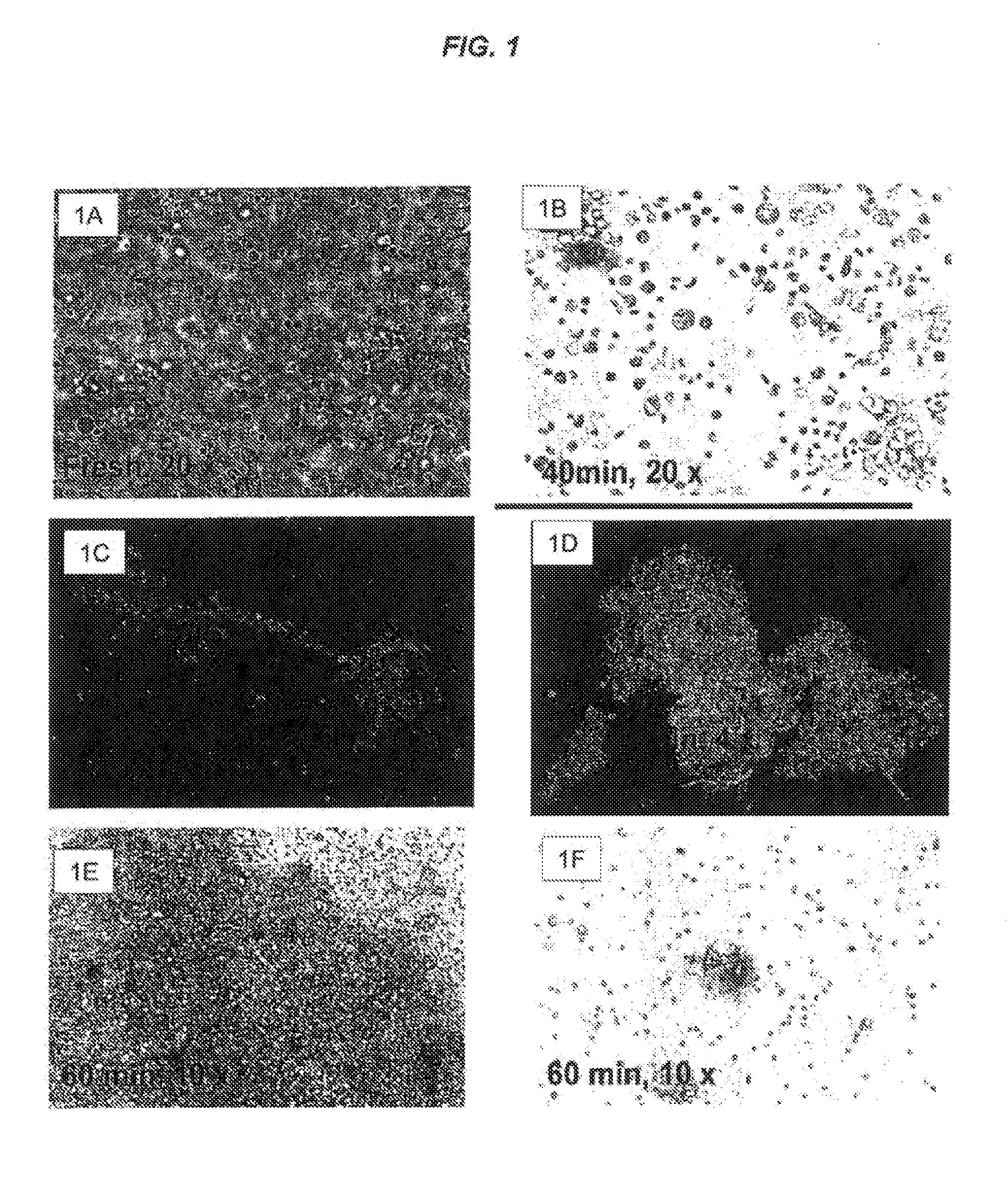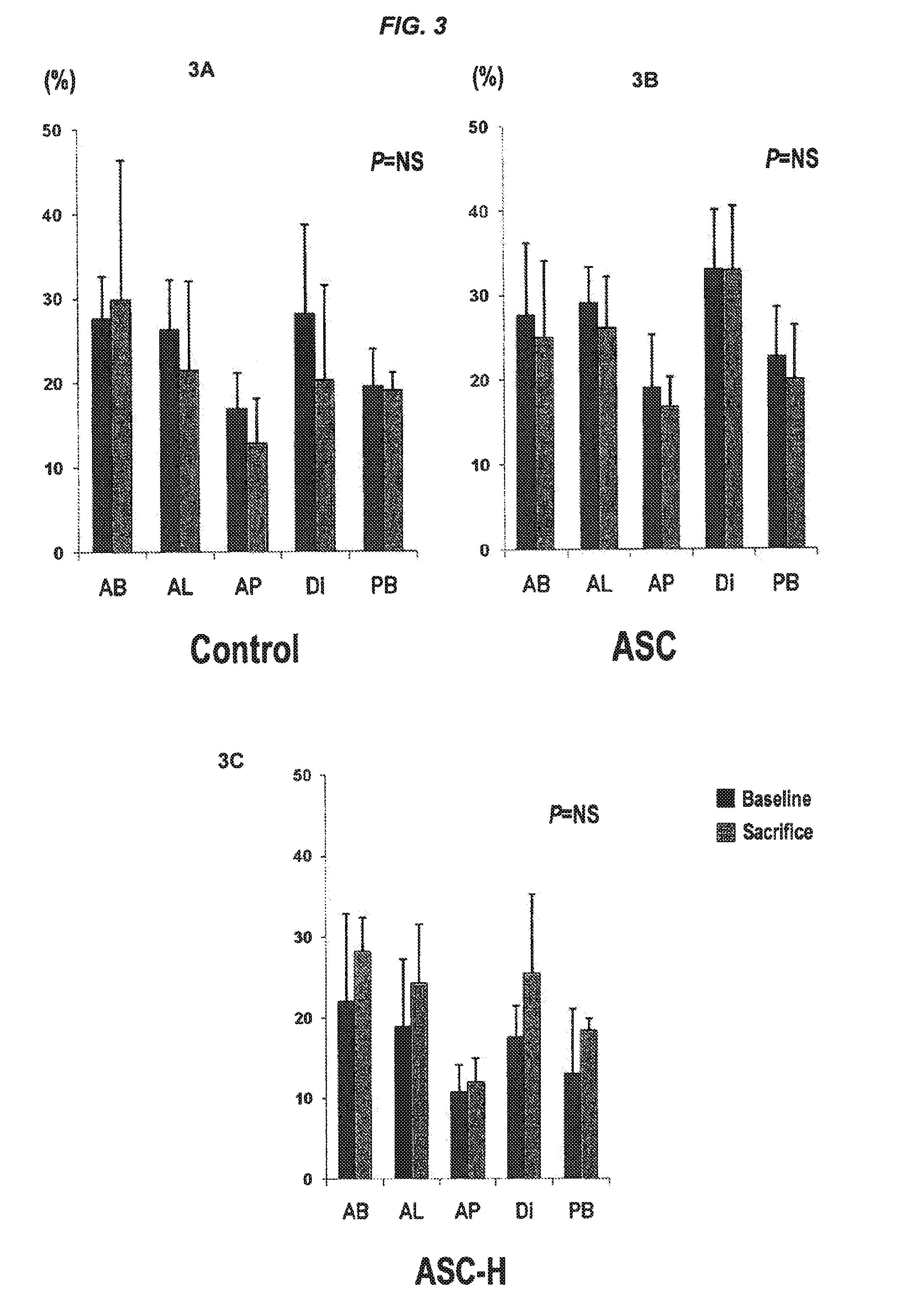Methods for preventing aggregation of adipose stromal cells
a technology of stromal cells and adipose tissue, which is applied in the field of regenerative cells derived from adipose tissue, can solve the problems of limited safety data available for the transplantation of these cells, loss of cardiac tissue, and impairment of the function of the left ventricular, so as to reduce the consequences of a myocardial infarction
- Summary
- Abstract
- Description
- Claims
- Application Information
AI Technical Summary
Benefits of technology
Problems solved by technology
Method used
Image
Examples
example 1
[0308]In brief, adipose stromal cells were harvested from fat for reinjection into the coronary arteries of pig hearts and it was observed that these cells formed macromolecular aggregates. Microscopic inspection of isolated cells in solution indicated that cell aggregates ranged from 4 cells (the lowest number of cells in an aggregate that could be reliably counted) to numbers which were too numerous to count. This aggregation phenomenon was observed with ASCs isolated from porcine and human fat that were either freshly harvested or had been cultured. The inventors conducted experiments to determine the nature of the properties of ASCs that contributed to aggregation, and lead to the discovery of methods and compositions to block ASC aggregation. Accordingly, the inventors demonstrate methods to inhibit or reduce ASC aggregation which are generally useful to those using ASCs, or other cell types with similar aggregative properties, for example, for therapeutic uses and transplantat...
example 2
[0315]Baseline cTn-I levels in all groups were <0.2 ng / ml (reference level: <0.2 ng / ml). At 24 hours after cell delivery, there was no detectable elevation in the control group. Seven of 9 (about 77%) of the animals in the ASC group (4.0±4.8 ng / ml) and all 4 animals (100%) in ASC-H group (0.3±0.21 ng / ml) exhibited an elevation of the cTn-I level at 24 hours. Thus, the inventors demonstrate at the 24 hour cTn-I timepoint, the ASC-H had a reduction of cTn-I elevation with heparin treatment as compared to ASC group. In all pigs, the cTn-I levels returned to normal 7 days after delivery. (FIG. 4)
Myocardial Infarction: TTC Staining and Histological Evaluation
[0316]In the control group, TTC staining and histological analysis did not show any infarctions. In the ASC group, 3 pigs had scattered small infarctions visible by TTC staining; and histological evaluation revealed myocardial infarctions in 6 of 9 pigs (about 66%). (FIG. 4) Five pigs had micros...
example 3
[0319]Arrhythmia: At baseline, no animals exhibited significant arrhythmia. Neither cell nor vehicle delivery caused any acute ventricular arrhythmias, bradycardia or conduction block. In the control group, the continuous recordings of 3 of 6 pigs (50%) were suitable for analysis. These pigs were monitored for 70.5±20.03 (48.9-74.0) hours after vehicle delivery, and revealed no significant dysrrhythmias. In the ASC group, the group of multiple infusion pigs (sacrificed by protocol at 1 day after the cell delivery), was monitored for at least 16 hours following cell delivery, with an average monitoring time of 17.9±1.12 hours. Among this group, one pig had cVR episodes which persisted until the time of euthanasia. The second group (sacrificed at 7th day) of pigs was monitored for 107.8±45.15 hours after the cell delivery. Among the second group of pigs, 4 of 5 (80%) had significant cVR episodes which terminated spontaneously as described below. In the ASC-H group, animals were monito...
PUM
| Property | Measurement | Unit |
|---|---|---|
| diameter | aaaaa | aaaaa |
| concentrations | aaaaa | aaaaa |
| temperatures | aaaaa | aaaaa |
Abstract
Description
Claims
Application Information
 Login to View More
Login to View More - R&D
- Intellectual Property
- Life Sciences
- Materials
- Tech Scout
- Unparalleled Data Quality
- Higher Quality Content
- 60% Fewer Hallucinations
Browse by: Latest US Patents, China's latest patents, Technical Efficacy Thesaurus, Application Domain, Technology Topic, Popular Technical Reports.
© 2025 PatSnap. All rights reserved.Legal|Privacy policy|Modern Slavery Act Transparency Statement|Sitemap|About US| Contact US: help@patsnap.com



